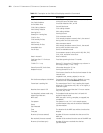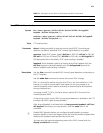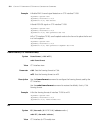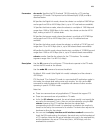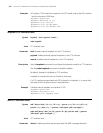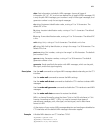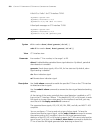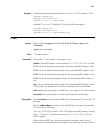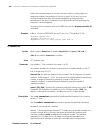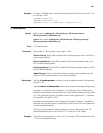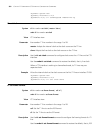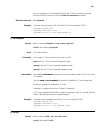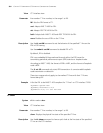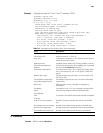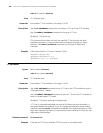
280 CHAPTER 17: FUNDAMENTAL CT3 INTERFACE CONFIGURATION COMMANDS
checks the received pattern for the bit error rate, and by so doing helps you
determine whether the condition of the line is good. To this end, you must
configure loopback to allow the transmitted pattern to loop back from
somewhere on the line, for example, from the far-end interface by placing the
interface in far-end loopback.
You may view the state and result of the BERT test with the display controller t3
command.
Example # Run a 10-minute QRSS BERT test on T1 line 1 on CT3 interface T3 2/0.
<Sysname> system-view
[Sysname] interface t3 2/0
[Sysname-T3 2/0] t1 1 bert pattern qrss time 10
t1 channel-set
Syntax t1 line-number channel-set set-number timeslot-list list [ speed { 56k | 64k }]
undo t1 line-number channel-set set-number
View CT3 interface view
Parameter line-number: T1 line number in the range 1 to 28.
set-number: Number of a channel set formed from a timeslot bundle on the T1
line. It ranges from 0 to 23.
timeslot-list list: Specifies timeslots to be bundled. The list argument is timeslot
numbers, in the range of 1 to 24. You may specify a single timeslot by specifying a
number, a range of timeslots by specifying a range in the form of
number1-number2, or several discrete timeslots by specifying number1,
number2-number3.
speed { 56k | 64k }: Speed of the timeslot bundle (the channel set) in kbps. If 56k
is selected, the timeslots is bundled into an N × 56 kbps bundle. If 64k, the
default, is selected, the timeslots is bundled into an N × 64 kbps bundle.
Description Use the
t1 channel-set command to bundle specified timeslots into a channel
set on a T1 line.
Use the
undo t1 channel-set command to remove the specified channel set.
By default, no channel set is created.
When a T1 line is operating in framed (CT1) mode, you can bundle timeslots on it.
For each channel set thus formed, the system automatically creates a serial
interface numbered serial number/line-number:set-number. This interface
operates at N × 64 kbps (or N × 56 kbps) and is logically equivalent to a
synchronous serial interface on which you can make other configurations.
Related command: t1 unframed.



